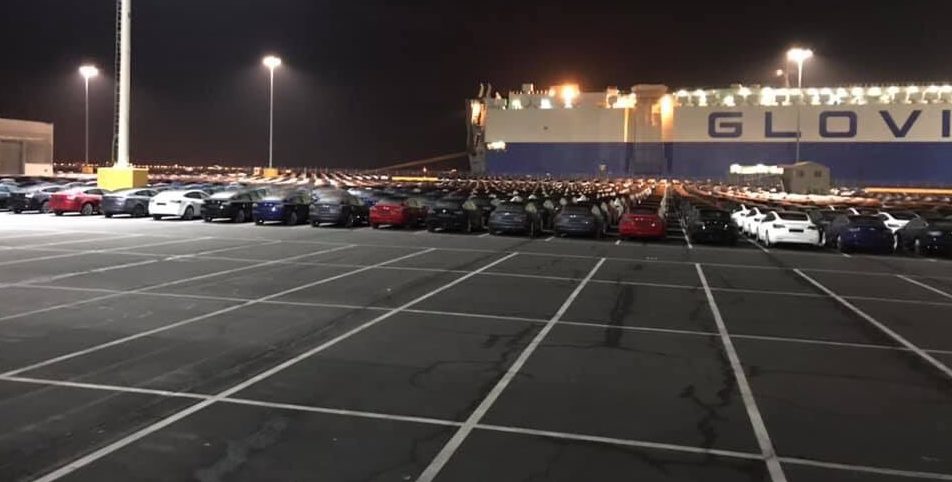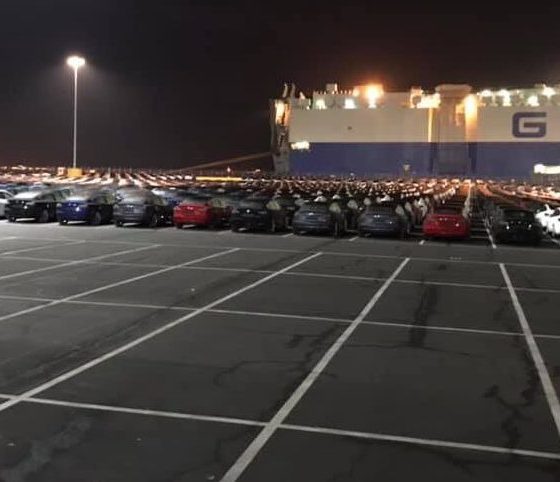

News
Tesla’s Model 3 delivery challenges in Europe are growing pains for a global ramp
The arrival of the cargo ship Glovis Captain on the port of Zeebrugge earlier this week heralded new opportunities and challenges for electric car maker Tesla. The massive vessel is estimated to be carrying around 3,000 Model 3, which are expected to start an electric disruption in Europe’s passenger car market. At the same time, the arrival of the highly-anticipated sedan also means that deliveries to reservation holders in the region are about to begin.
Delivery Logistics Hell, Part 2
In true Tesla fashion, plans were underway to get the recently-arrived Model 3 to customers as quickly as possible. Thus, instead of taking a while before starting handovers to reservation holders in the region, Tesla immediately went to work. Reports from the Tesla community even indicated that they received messages from the carmaker indicating that they could pick up their Model 3 starting Wednesday at the company’s Tilburg facility, shortly after the cars arrived on Zeebrugge.
Soon, social media posts from the Tesla community revealed that the first Model 3 deliveries in Europe were already underway. That said, it did not take long before Tesla became unable to deliver as many vehicles as they estimated. Some reservation holders even went so far as to state that they were advised to pick up their Model 3 the following day. While an additional day is but a drop in the bucket compared to the nearly three-year wait for the electric sedan experienced by reservation holders, Tesla’s inability to deliver as many vehicles as it expected became a great inconvenience nonetheless.
On Wednesday, Elon Musk took to Twitter to apologize for the delivery delay in Europe. In a tweet, Musk explained that Tesla met some “unexpected challenges” with the vehicles coming through the Belgian port. Nevertheless, Musk noted that Model 3 deliveries should start moving on Thursday.
Sorry, many unexpected challenges with cars coming through Zeebrugge first time. Cars will start moving out in volume tomorrow.
— Elon Musk (@elonmusk) February 6, 2019
Logistics Challenges – Not Sweeter the Second Time
Ultimately, this is yet another case of Tesla miscalculating and shooting itself in the foot in the process. In the case of Europe’s first Model 3 deliveries, reservation holders were expecting their vehicles at a later date to begin with (the reservation holder Musk responded to on Twitter, for example, had a delivery date of 02/16/2019). The earlier delivery estimates, and the succeeding failure to meet said estimates, all transpired under Tesla’s own doing.
That said, Tesla’s journey with the Model 3 to date hints at something positive following the company’s logistics challenges in Europe, considering that the electric car maker faced the same issues in the US last September. During that time, Tesla was just hitting its stride with the production of the electric sedan. Tesla was also going for profitability, which required a record number of vehicle deliveries. Tesla’s deliveries became so backlogged that reservation holders saw their handover dates rescheduled multiple times.
Thanks to @LucWaterlot, some pictures of #glovisCaptain arriving full of #tesla #Model3 in #portofzeebrugge pic.twitter.com/rVxWBkWHNU
— FalconU (@UlricDabe) February 5, 2019
Just like Elon Musk’s recent tweet, the Tesla CEO owned up to Tesla’s challenges then, explaining that the company had gone straight from “production hell” to “delivery logistics hell.” Musk also mentioned later that challenges in logistics are easier to solve than production issues. True to the CEO’s word, Tesla delivered a record number of vehicles in the third quarter, with Q3 2018 handovers totaling 83,500 vehicles including 55,840 Model 3. Ultimately, these deliveries helped the company achieve its first definitively profitable quarter in years. These logistics challenges were completely absent in Q4 2018 as well, when Tesla delivered a total of 90,700 vehicles, including 63,150 Model 3.
Lessons Learned and Experiences Gained
With this in mind, it appears that Tesla’s current challenges in delivering the Model 3 to European customers are something that the company can handle. Tesla’s experience in the United States alone should help the electric car maker gain enough footing to conduct handovers in the region in a manner that is smooth, convenient, and well worth the nearly three-year wait for Model 3 reservation holders.
While Tesla appears to have miscalculated its initial European Model 3 deliveries, the company is in a constant effort to improve its logistics. Elon Musk took particular notice of this issue in the recently held Q4 2018 earnings call, when he was discussing the probability of Q1 2019’s profitability.
“We’re going to get cars to China and Europe and make sure that we have good logistics for the whole delivery process, from factory gate to the customer. That’s obviously pretty far from California to get to Europe and China and make it to, again, our two customers. So, we’re working every aspect of that logistics chain. And I think we’ve — I think it’s going to be good. I would say at this point; I’m optimistic about being profitable in Q1. Not by a lot, but I’m optimistic about being profitable in Q1 and for all quarters going forward,” Musk said.
For the meantime, the beast that is the Tesla Model 3 is still waiting for its chance to fully saturate the European market.

News
Tesla FSD fleet is nearing 7 billion total miles, including 2.5 billion city miles
As can be seen on Tesla’s official FSD webpage, vehicles equipped with the system have now navigated over 6.99 billion miles.

Tesla’s Full Self-Driving (Supervised) fleet is closing in on almost 7 billion total miles driven, as per data posted by the company on its official FSD webpage.
These figures hint at the massive scale of data fueling Tesla’s rapid FSD improvements, which have been quite notable as of late.
FSD mileage milestones
As can be seen on Tesla’s official FSD webpage, vehicles equipped with the system have now navigated over 6.99 billion miles. Tesla owner and avid FSD tester Whole Mars Catalog also shared a screenshot indicating that from the nearly 7 billion miles traveled by the FSD fleet, more than 2.5 billion miles were driven inside cities.
City miles are particularly valuable for complex urban scenarios like unprotected turns, pedestrian interactions, and traffic lights. This is also the difference-maker for FSD, as only complex solutions, such as Waymo’s self-driving taxis, operate similarly on inner-city streets. And even then, incidents such as the San Francisco blackouts have proven challenging for sensor-rich vehicles like Waymos.
Tesla’s data edge
Tesla has a number of advantages in the autonomous vehicle sector, one of which is the size of its fleet and the number of vehicles training FSD on real-world roads. Tesla’s nearly 7 billion FSD miles then allow the company to roll out updates that make its vehicles behave like they are being driven by experienced drivers, even if they are operating on their own.
So notable are Tesla’s improvements to FSD that NVIDIA Director of Robotics Jim Fan, after experiencing FSD v14, noted that the system is the first AI that passes what he described as a “Physical Turing Test.”
“Despite knowing exactly how robot learning works, I still find it magical watching the steering wheel turn by itself. First it feels surreal, next it becomes routine. Then, like the smartphone, taking it away actively hurts. This is how humanity gets rewired and glued to god-like technologies,” Fan wrote in a post on X.
News
Tesla starts showing how FSD will change lives in Europe
Local officials tested the system on narrow country roads and were impressed by FSD’s smooth, human-like driving, with some calling the service a game-changer for everyday life in areas that are far from urban centers.

Tesla has launched Europe’s first public shuttle service using Full Self-Driving (Supervised) in the rural Eifelkreis Bitburg-Prüm region of Germany, demonstrating how the technology can restore independence and mobility for people who struggle with limited transport options.
Local officials tested the system on narrow country roads and were impressed by FSD’s smooth, human-like driving, with some calling the service a game-changer for everyday life in areas that are far from urban centers.
Officials see real impact on rural residents
Arzfeld Mayor Johannes Kuhl and District Administrator Andreas Kruppert personally tested the Tesla shuttle service. This allowed them to see just how well FSD navigated winding lanes and rural roads confidently. Kruppert said, “Autonomous driving sounds like science fiction to many, but we simply see here that it works totally well in rural regions too.” Kuhl, for his part, also noted that FSD “feels like a very experienced driver.”
The pilot complements the area’s “Citizen Bus” program, which provides on-demand rides for elderly residents who can no longer drive themselves. Tesla Europe shared a video of a demonstration of the service, highlighting how FSD gives people their freedom back, even in places where public transport is not as prevalent.
What the Ministry for Economic Affairs and Transport says
Rhineland-Palatinate’s Minister Daniela Schmitt supported the project, praising the collaboration that made this “first of its kind in Europe” possible. As per the ministry, the rural rollout for the service shows FSD’s potential beyond major cities, and it delivers tangible benefits like grocery runs, doctor visits, and social connections for isolated residents.
“Reliable and flexible mobility is especially vital in rural areas. With the launch of a shuttle service using self-driving vehicles (FSD supervised) by Tesla in the Eifelkreis Bitburg-Prüm, an innovative pilot project is now getting underway that complements local community bus services. It is the first project of its kind in Europe.
“The result is a real gain for rural mobility: greater accessibility, more flexibility and tangible benefits for everyday life. A strong signal for innovation, cooperation and future-oriented mobility beyond urban centers,” the ministry wrote in a LinkedIn post.
News
Tesla China quietly posts Robotaxi-related job listing
Tesla China is currently seeking a Low Voltage Electrical Engineer to work on circuit board design for the company’s autonomous vehicles.

Tesla has posted a new job listing in Shanghai explicitly tied to its Robotaxi program, fueling speculation that the company is preparing to launch its dedicated autonomous ride-hailing service in China.
As noted in the listing, Tesla China is currently seeking a Low Voltage Electrical Engineer to work on circuit board design for the company’s autonomous vehicles.
Robotaxi-specific role
The listing, which was shared on social media platform X by industry watcher @tslaming, suggested that Tesla China is looking to fill the role urgently. The job listing itself specifically mentions that the person hired for the role will be working on the Low Voltage Hardware team, which would design the circuit boards that would serve as the nervous system of the Robotaxi.
Key tasks for the role, as indicated in the job listing, include collaboration with PCB layout, firmware, mechanical, program management, and validation teams, among other responsibilities. The role is based in Shanghai.
China Robotaxi launch
China represents a massive potential market for robotaxis, with its dense urban centers and supportive policies in select cities. Tesla has limited permission to roll out FSD in the country, though despite this, its vehicles have been hailed as among the best in the market when it comes to autonomous features. So far, at least, it appears that China supports Tesla’s FSD and Robotaxi rollout.
This was hinted at in November, when Tesla brought the Cybercab to the 8th China International Import Expo (CIIE) in Shanghai, marking the first time that the autonomous two-seater was brought to the Asia-Pacific region. The vehicle, despite not having a release date in China, received a significant amount of interest among the event’s attendees.








